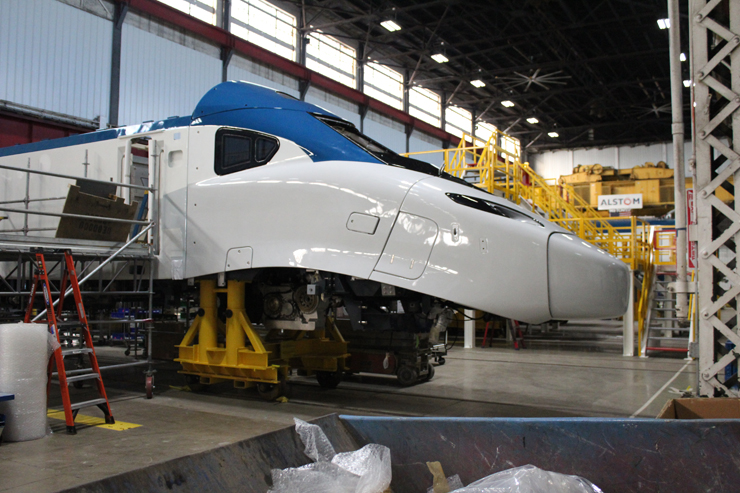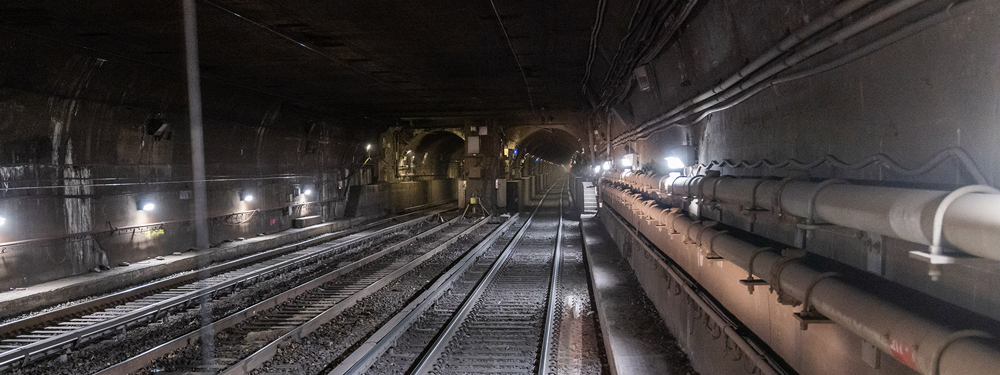WASHINGTON — A day after Amtrak released a video of its new Acela trainset moving for the very first time, the passenger carrier’s Office of Inspector General released a report warning there is “significant risk” the company will not meet its 2021 deadline to put the new high-speed train into service.
Alstom is currently building 28 Acela trainsets in Hornell, N.Y. and Amtrak officials hope to have the trains in service on the Northeast Corridor next year [See: “Amtrak’s new Alstom-made Acela trainset moves in Hornell, N.Y.,” Trains News Wire, Jan. 22, 2020]. The “Acela 21” program has cost $2.1 billion and is the single largest investment in the company’s 49-year history. But in a report released on Thursday, Assistant Inspector General Jim Morrison says it’s likely that Amtrak will miss its target.
“The Acela 21 program is entering a critical stage if it is to begin revenue service on time,” the report states. “So far, the Acela 21 program has employed some sound program management practices. Nevertheless, management and structural weaknesses still pose significant risks. Foremost is that project delays have eliminated any cushion in the schedule, and multiple indicators point to further delays beyond the planned service launch in 2021.”
According to the report, Amtrak has not upgraded maintenance facilities or information technology systems to handle the new train. nor has it trained more than 1,000 maintenance and onboard personnel on the intricacies of the new Acela.
Alstom originally planned to deliver up to nine trainsets in 2021, but it is unclear if the manufacturer can meet that deadline.
The report notes Amtrak planned on taking an old Acela train out of service every time a new one arrived on the property. But managers tell the Office of Inspector General that plan has changed. No Acela will be taken out of service until there is confidence the new train can run in a specific time slot.
The report concludes construction and testing would have go “flawlessly” in order to meet the deadline. If Amtrak does miss the deadline, it will likely lose revenue because it will not be able to sell additional seats on trains. Each new Acela trainset will have 82 more seats than the original.
The report recommends that Amtrak ensure the managers assigned to the Acela 21 project are given the proper capacity to focus on and finish the project. It also recommends that management come up with contingency plans in case the delivery schedule falls further behind. In comments at the end of the report, Amtrak officials say they agree with the report’s findings and would implement its recommendations.
The report was the result of months of interviews with Amtrak managers in late 2019 and early 2020.















Failure to plan is a plan to fail. You never take functioning equipment out of service just so you can replace it with the latest and greatest when the newest has not been fully tried out. Always and I repeat always plan for something to not go right. Just ask the airline people what happened when they started running most flights with their shinny new 737 max 8 jets and they had to ground that fleet.
Those “airline folks” are used to offering that “nuisance” called customers “take it or leave it” with a “service” akin to what a cow receives from a bull on a feedlot. As for “missing revenue”, I’m surprised that Amtrak hasn’t gone to more of a “demand based” formula for fares, like the airlines. There is no reason why any perceived fare “shortfall” can;t be covered by overbooking like the airlines do. Then, if too many people show up for a given train, you simply “bump” the lower fare passengers first. Which makes me wonder… do Amtrak passengers get “protections” akin to airline passengers, if bumped?
Yes but you have to admit the bumbling airline folks are ill equipped to make these decisions and too proud to ask for help!
And so Richard Anderson’s airline model of implementation takes another hit PROVING non railroad experienced managers have no business running a mechanical oriented transportation system as a railroad, albeit a passenger railroad. When your jet plane introduction doesn’t come off as planned, you simply reshuffle your line up and reallocate your assets and carry on. However, when your rail implementation doesn’t happen and your back up equipment has already been cannibalized or scrapped, you just don’t go to equipment storage and pull out equipment sidelined and reallocate to keep the system running. The problem with Anderson and his teams vision is it doesn’t go much beyond they can actually see and this type of new approach takes someone who can look beyond the end of his nose!
This pales compared to the CAF production times of diners, sleepers, baggage cars, transitions etc for the rest of East LD trains!!! Does nobody question this? Or are we so worn down by such pathetic production schedules (i.e. delays!?)
Perhaps Amtrak can cancel the contract with Alstom as it did Sharyo with the proposed new coaches for California regional trains. Siemens was available to take that project. It would be available for this project of the next generation of Acela Express fleets.
I remember the first Acela’s and the issues and delays they had. Alstom at the time blamed the delays by the constant changes being requested by Amtrak management after the design and engineering had been completed. Then the stress cracks came and suppliers had to change. The body was vibrating at speed due to excess weight, which was blamed on last minute demands from Amtrak for certain amenities to be included.
When it was all said and done most of the blame centered on the length of time to get the set designed and built relative to the turnover in Amtrak management. Every new Amtrak manager would come in and demand certain things to change and Alstom had to accommodate them.
Today, no one in Amtrak management was around pre-Amtrak
Given the bumbling , non railroad, idiots presently in charge at Amtrak, how can an rational person believe almost anything they say!
Does the report say why it has been eating up its delivery cushion?
As if all of this is a surprise. It is after all a federal government operation.
Penelope, one major difference is that Alstom is already in production of the fleet; the first example will be in Colorado for testing next month. As I recall, Sharyo produced one body, which failed a compression test, and did basically nothing for 2-3 years. That forced a switch to Siemens to keep funding at the last minute, and a totally different car design as well (single vs bi-level).
Or is it a lack of competent management oversight at the highest levels? All those with any real-time railroad experience have either been fired (cost-cutting) or left due to the lousy morale created by the fly-boys.